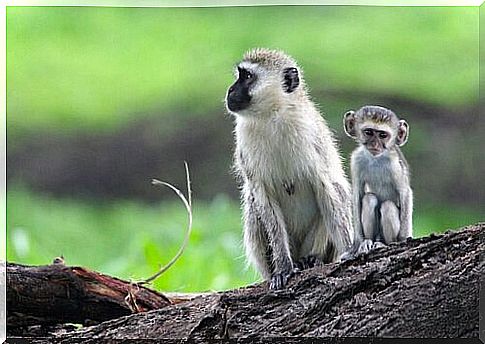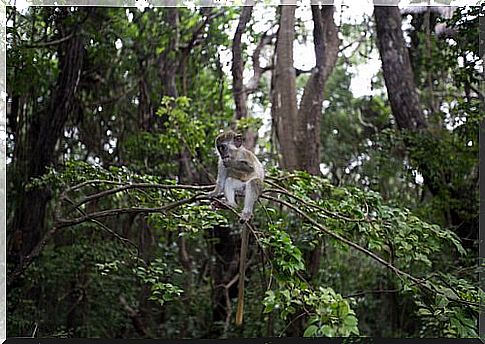The Green Monkey, From Egypt To The Labs

The green monkey lives with humans for millennia, which could be proven by the discovery of mummified animals.
Smallpox and polio were eradicated thanks to him and, in addition, he helped in the progress of the study of AIDS and hypertension.
The green monkey is a very unique type of primate. Despite being little known in the West, it has had a great impact on our lives. Furthermore, it has been related to the human being for millennia.
Green Monkey Characteristics
The green monkey is one of six members of the Chlorocebus genus , a group of African primates within cercopithecines. In it, other primates are found, such as the baboon or the monkeys.
The six species of green monkey have few differences. Their taxonomic classification has undergone several revisions and they hybridize and share territory. Therefore, we will talk about them without distinction here.
Regarding its physical characteristics, it is a medium-sized primate that does not exceed six kilos.
In addition, its fur is brown, with greenish and golden tones. He has yellowish fur on his stomach, thighs and cheeks, and his scrotum is blue. Hair colors vary little between different species.
green monkey habitat
Together, the different species of green monkey are the most abundant non-human primates in Africa.
They live in almost 40 different countries, from Ethiopia to Senegal. Thus, the limits of its distribution from north to south are marked by the Sahara and the tip of South Africa.
They are very successful primates. In other words, not only did they conquer almost all of Africa, they also became one of the most notable invasive species.
To give you an idea, they were seen stealing cocktails from tourists in Cape Verde and the Caribbean.

green monkey behavior
Its enormous variety of habitats shows that the green monkey is a generalist species that can adapt to various ecosystems.
One of the reasons is because it has one of the most varied diets among primates. It can consume flowers, fungi, berries, small mammals, insects or leaves.
This means that it has adapted to very different environments, some of them with a huge human presence and a small extension.
Therefore, the behavior of the green monkeys found in Senegal is different from that found in the Caribbean islands.

Groups generally average about 25 individuals, although this number can vary. The green monkey’s communication is very rich and interesting.
They have so-called indicators for terrestrial, aerial and snake predators. In addition, the way in which they learn it has been studied a lot.
The Green Monkey and Ancient Egypt
The green monkey’s relationship to our species is very interesting, even if you’ve probably never heard of it. This relationship goes back over 4,000 years and still remains in the present.
The green monkey was a revered species in ancient Egypt, one of the first countries to realize that having a monkey as a pet is very dangerous. Therefore, currently, this is prohibited in many countries.
In addition, much evidence of this species has been found in the Rift Valley, and even remains of green monkeys with iron collars or mummified ones. This shows the relationship of these animals in ancient Egypt.
The green monkey and the human being in the present
However, the relationship of the human being with the green ape is not that distant today. The kidney of this primate was used to make cell cultures that allowed to eradicate diseases such as smallpox and polio.
Furthermore, and unfortunately for these animals, the human being makes several experiments with them. Although this is seen as cruel by many people, the truth is that, thanks to the sacrifice of these animals, we have advanced decades in the study of hypertension and even AIDS.
After all, the green monkey is not only one of the most widely distributed primates, but also one of the few that is not at risk of extinction.
This makes green monkeys considered a pest, as they have adapted to stealing food from crops, markets or tourist areas.









